Emerald Cut Diamond Proportions and Insights
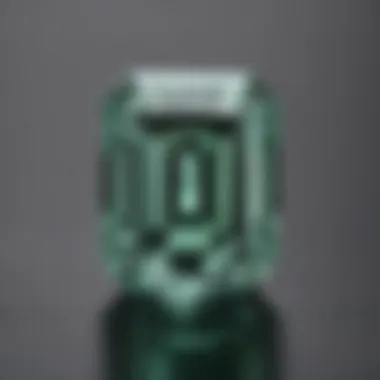
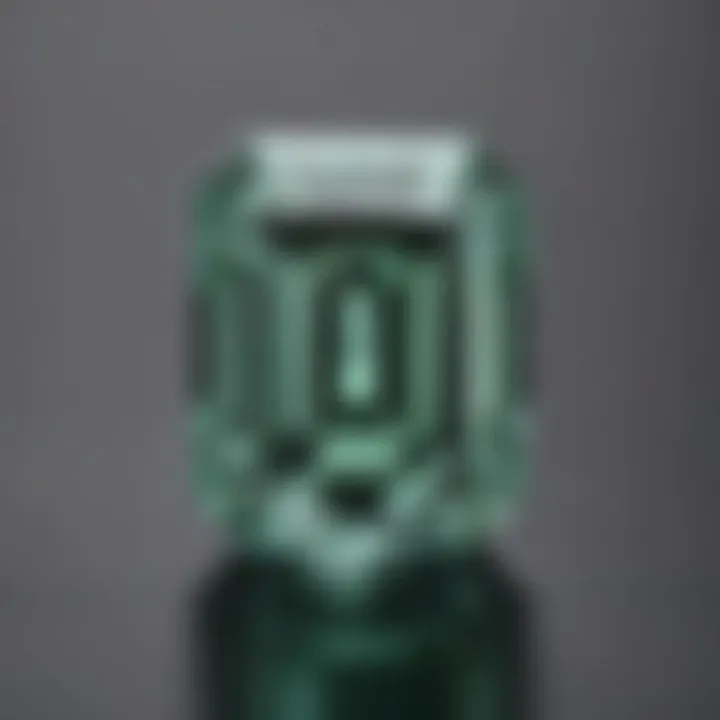
Intro
When it comes to the world of gemstones, the emerald cut diamond holds a unique position. Known for its elegance, the emerald cut features a rectangular shape with clipped corners, which sets it apart from the round brilliant cut that often dominates discussions in this space. Its beauty lies not only in its distinct shape but also in how the cut interacts with light, resulting in a subtle yet captivating sparkle. In this article, we embark on a journey to understand the ideal proportions that make emerald cut diamonds so sought after. We will explore the characteristics that affect their brilliance and value, the meticulous factors to consider when purchasing, and tips for maintaining the beauty of these sparkling stones.
Gemstone Overview
Definition of Gemstones
Gemstones are natural minerals, rocks or organic materials prized for their beauty and rarity. They undergo cutting and polishing to enhance their visual appeal and are often set in jewelry to showcase their splendor. What distinguishes gemstones is not just their composition but also their historical significance and cultural importance throughout time.
Classification of Gemstones
Gemstones can be classified into two broad categories: precious and semi-precious stones. Precious stones, such as diamonds, rubies, sapphires, and emeralds, are valued for their rarity and superior quality. In contrast, semi-precious stones include a wider range and are often more abundant.
- Precious Gemstones:
- Semi-Precious Gemstones:
- Diamonds
- Rubies
- Sapphires
- Emeralds
- Amethyst
- Aquamarine
- Garnet
- Topaz
Understanding the classification helps buyers discern quality and value, ultimately aiding in making informed choices.
Historical Significance
Origins of Gemstone Use
Historically, gemstones have held their ground as symbols of wealth, power, and status across different cultures. The use of gemstones can be traced back thousands of years. Ancient civilizations utilized these stones not only for adornment but also for their supposed mystical properties. The allure of gemstones perhaps started with their natural beauty and evolved into deeper significance as ancient societies began to attribute meaning to different stones.
Cultural Insights: Gemstones in Ancient Civilizations
Many ancient civilizations revered gemstones. For instance, the Egyptians valued lapis lazuli for its rich blue hue and often incorporated it into their jewelry. The Romans believed in the protective properties of amethyst, while the Greeks associated diamonds with divine love. Each gem reflected the culture's beliefs, practices, and even religion.
"In every corner of the globe, gemstones tell stories - of creation, culture, and human aspiration."
As we delve deeper into emerald cut diamonds, understanding these gemstones’ roots enriches our appreciation for them. Each facet, each cut has its own tale woven into the fabric of human history. Whether for collectors, enthusiasts, or designers, the emerald cut diamond represents not just a piece of jewelry but a story that transcends time.
Foreword to Emerald Cut Diamonds
In the fascinating realm of gemstones, emerald cut diamonds command a unique presence. Their geometric lines and alluring flashes of light set them apart from other diamond cuts, providing an exclusive charm that appeals to many. This section invites you to consider the intrinsic characteristics of emerald cut diamonds and their historical journeys, emphasizing why they deserve a place in the spotlight.
Emerald cut diamonds are more than just sparkly rocks. Their broad, open table reflects light in a way that allows one to appreciate the diamond's clarity and color more deeply. Many enthusiasts value these aspects because they engender an appreciation for the natural beauty of the stone. Whether you are a collector, a designer, or someone searching for that perfect engagement ring, understanding the features of emerald cuts can greatly enhance your selection process.
Moreover, the historical context of emerald cut diamonds has its own allure. Few cuts can claim lineage that intertwines with royalty and classic elegance quite like the emerald. Offering insight into their rich past not only enhances your knowledge but also adds depth to your appreciation of these gems. Consequently, knowing where the emerald cut comes from underscores its significance in both contemporary and historical jewelry design.
Historical Context
Emerald cut diamonds trace their roots back to the early 20th century, gaining popularity during the Art Deco period. This period was a time when geometry influenced design, and the emerald cut fit right into this aesthetic with its clean lines and rectangular shape. While the name suggests a link to emerald gemstones, the cut was actually developed for diamonds to showcase their clarity and size.
Initially crafted for emeralds, jewelers recognized that the style's straight edges and broad facets allowed the cut to emphasize transparency rather than intense brilliance. Notably, this can be tied to the wider trends in the jewelry of the time that favored a more understated elegance rather than the flashy sparkle of brilliant cuts.
Throughout history, emerald cut diamonds have adorned some powerful figures. For instance, icons like Elizabeth Taylor and Beyoncé selected these shapes for their immense symbolism and luxury. The deep appreciation for these pieces can be seen not just in their aesthetic but also in their historical significance. They represent a mix of opulence, sophistication, and timelessness.
Distinct Features of the Emerald Cut
What sets emerald cut diamonds apart? Firstly, the cut is defined by its rectangular or square shape, combining its length and width in a way that draws the eye. A common feature is the "step cut" facet arrangement, which results in a series of broad, flat planes creating an optical effect that’s distinct to this style.
The most notable aspect of an emerald cut diamond is its unique ability to reveal clarity. Unlike other diamond shapes that mask inclusions with added sparkle, the emerald cut flaunts clarity like a badge of honor. Its large facets allow light to flow through the stone in a way that highlights its inherent beauty.
Additionally, the dramatic corners of the emerald cut give it a hint of boldness and sophistication. Customers frequently appreciate this feature because it offers a sense of strength and stability that is often seen in architectural design.
In summary, whether one considers the emerald cut's journey through time or its striking features that address clarity and form, it's clear that these diamonds hold a captivating story that enchants gem enthusiasts and casual admirers alike.
Understanding Diamond Proportions
In the realm of emerald cut diamonds, the significance of understanding diamond proportions cannot be overstated. This concept encapsulates various numerical aspects that contribute directly to the beauty, brilliance, and overall appeal of these exquisite stones. Proper comprehension of proportions helps potential buyers make informed decisions, ensuring they select a diamond that not only dazzles in appearance but also represents a sound investment. In this section, we will explore definitions and principles that form the backbone of emerald cut diamond evaluation to guide enthusiasts and buyers alike through their diamond journey.
Key Proportional Terms
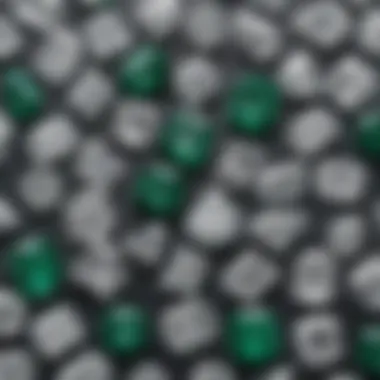

When stepping into the world of diamond evaluation, it's crucial to familiarize oneself with the key proportional terms that often dominate discussions. Here are some essential ones:
- Length to Width Ratio: This measurement defines the overall shape of the diamond. For emerald cuts, an ideal ratio typically ranges from 1.30 to 1.50. A ratio that is too low could yield a square appearance, while a higher ratio creates a longer, more elegant look.
- Table Size: The table refers to the flat top facet of the diamond. The size of the table can also affect the perception of brilliance. A well-balanced table offers a good mix of sparkle and clarity, ideally being 60-70% of the diameter.
- Depth Percentage: This percentage reflects how deep the diamond is relative to its diameter. An ideal depth percentage for emerald cuts is usually between 60-70%. Going beyond this range can impact the diamond's light performance.
- Crown Angle: The angle of the crown's facets plays a major role in light reflection. A crown angle of between 34 to 37 degrees is often deemed suitable for emerald cuts.
- Pavilion Angle: The angle at which the pavilion facets are cut can greatly influence how the diamond reflects light. Typically, a pavilion angle ranging from 40 to 42 degrees works best.
Each of these terms connects back to the intricate relationships among the diamond's facets, creating a hierarchy in terms of aesthetics and light behavior. Recognizing these terms leads to a deeper appreciation of how each element contributes to the overall characteristic of emerald cut diamonds.
Importance of Symmetry
Symmetry is a critical factor that plays a vital role in the appearance and overall quality of emerald cut diamonds. When one speaks about symmetry in diamonds, it is not merely about the evenness of cuts; it encompasses a well-balanced aspect that speaks volumes about the craftsmanship.
A diamond with high symmetry appears more visually appealing and tends to exhibit better light performance. Here are a few points to consider:
- Visual Appeal: A symmetric diamond looks polished and deliberate. In contrast, a lack of symmetry can make a diamond appear uneven, dulling its appeal.
- Light Performance: Well-symmetrized stones better harness and disperse light. This ultimately leads to more luminosity and brilliance, creating a captivating visual experience for the onlooker.
- Value Implications: Consumers often equate symmetry with quality. A diamond that exhibits exceptional symmetry can command higher prices in the market, as it’s seen as more desirable.
To put it simply, while many buyers get swept away by the flashiness of diamonds, understanding that a symmetric cut can significantly magnify the beauty and value can lead to a more satisfying purchase.
"A diamond’s brilliance doesn’t just come from its clarity or how big it is; symmetry shapes that brilliance into something spectacular."
Ideal Proportions for Emerald Cut Diamonds
When it comes to emerald cut diamonds, proportions are pivotal in determining both their allure and worth. Unlike other cuts, where brilliance might take center stage, the emerald cut offers a more understated elegance. The essence of an emerald cut is its ability to showcase clarity and color, which can often be lost in more sparkly cuts. By focusing on ideal proportions, one ensures that the diamond performs beautifully, providing a captivating view that doesn’t scream but rather whispers sophistication. Understanding these proportions helps buyers make informed choices, ensuring their investment is sound not just in monetary value but also in visual appeal.
Length to Width Ratio
The length to width ratio is a critical factor when choosing an emerald cut diamond. Ideally, this ratio should range between 1.30 to 1.50. A higher ratio typically results in a more elongated, elegant appearance, while a lower ratio can offer a squarer look.
Why does this matter? Consider this:
- Visual Appeal: An elongated diamond often appears larger than it is, providing an illusion of greater size without the hefty price tag.
- Proportion Harmony: The right ratio harmonizes with settings and various styles, enhancing the overall piece of jewelry.
- Personal Preference: Some people simply prefer one shape over another, and it's essential to choose based on personal taste, as jewelry often expresses individuality.
Table Size and Depth Percentage
The table size— the flat surface on the top of the diamond— and the depth percentage—how deep the stone is from the table to the culet— are also significant in determining an emerald cut's beauty and brilliance.
- Table Size: Ideally, this should be about 60% to 70% of the total width of the diamond. A larger table relative to the stone's size can enhance light performance, but too large could flatten the brilliance.
- Depth Percentage: This should be somewhere around 61% to 67%. A deeper percentage can offer more depth but may hinder light reflection, reducing the sparkle.
Balancing these aspects can be tricky. You want a diamond that catches the eye without compromising on brilliance.
Crown and Pavilion Angles
Finally, let's talk about crown and pavilion angles. These angles are not just numbers; they play a crucial part in how light travels through the stone. The crown angle is typically between 30 to 34 degrees, while the pavilion angle generally falls between 40 to 42 degrees.
Why do these angles matter?
- Light Utilization: The ideal angles encourage the best reflection and refraction of light, enhancing the overall sparkle.
- Visual Size: Well-angled stones often give the illusion of being larger and more lustrous than their actual carat weight would suggest.
- Durability: Properly cut angles also contribute to the overall resilience of the diamond, reducing the risk of chipping during wear.
"A well-proportioned emerald cut is like a finely crafted work of art, revealing layers of depth and clarity that enhance its natural beauty."
Evaluating the Quality of Emerald Cut Diamonds
Evaluating the quality of emerald cut diamonds is a fundamental aspect for anyone looking to appreciate or invest in these gems. This process requires an understanding of how various elements, notably clarity and color, play pivotal roles in determining a diamond's overall appeal. Not only do these characteristics influence the diamond's visual allure, but they also significantly affect its market value. Given the particularities of the emerald cut, which emphasizes clarity due to its large, open surface, appraisal can be somewhat different from other cuts. Thus, it's crucial to grasp these qualities fully, especially for enthusiasts and potential buyers.
Clarity and Color Considerations
When diving into clarity and color, it’s essential to recognize that these two factors are often intertangled in the conversation about emerald cut diamonds. Clarity refers to the presence of inclusions or blemishes within or on the diamond, while color pertains to the hue of the diamond itself.
Emerald cut diamonds tend to show inclusions more readily because of their broad facets. A diamond with high clarity will generally exhibit a clean appearance that allows light to flow uninterrupted, creating a sparkling effect. Most buyers aim for clarity grades of VS2 (Very Slightly Included) or better for optimal aesthetic appeal. In contrast, if a stone falls short on this front, it can sometimes detract from the diamond’s overall charm, making it less desirable.
Color also plays a role, albeit indirectly. The ideal emerald cut diamond is usually colorless or near-colorless (graded D to G). The open nature of this cut means that any color in the diamond becomes more visible. Therefore, choosing a diamond that falls into the colorless range will enhance its brilliance, allowing the light to bounce off the facets freely. Even a hint of color in lower-quality stones can be pronounced, impacting not just how the diamond looks, but how it's perceived in terms of worth.
"In clarity and color, the brilliance of an emerald cut diamond emerges, translating the stone's quality into visual poetry."
Impact on Value
The impact of clarity and color on the value of emerald cut diamonds cannot be overstated. Buyers often grapple with the balance between price and quality, and understanding these two elements is pivotal in making informed decisions.
Here’s a breakdown of how these characteristics influence value:
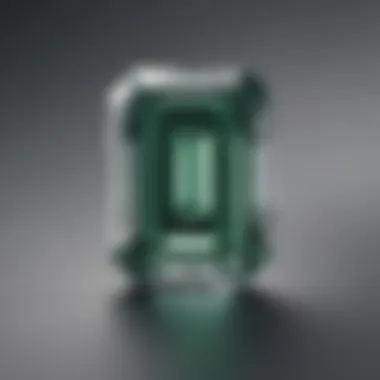
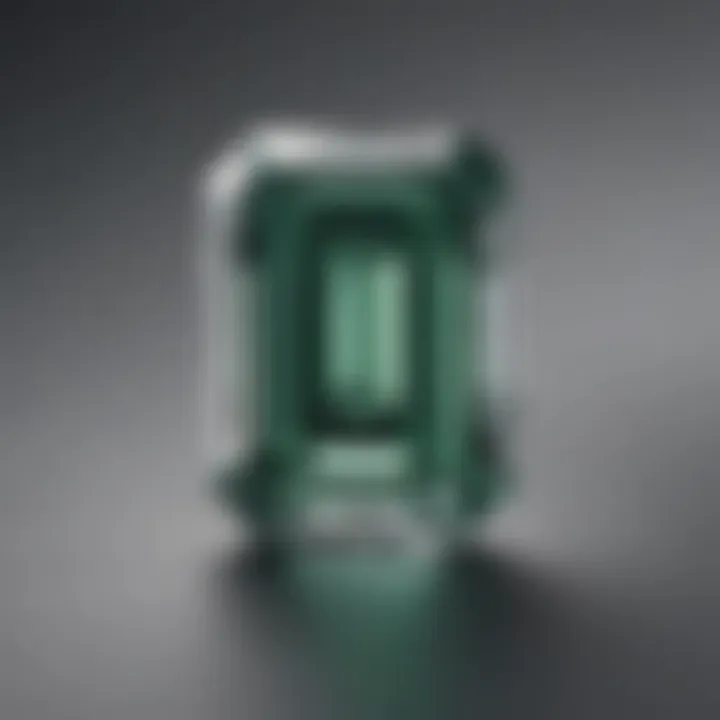
- Clarity Impact:
- Color Impact:
- Desirability and Rarity:
- Higher clarity grades typically lead to higher prices. A diamond with no visible inclusions will command a premium price compared to one with noticeable flaws.
- VS1 to VVS2 (Very Very Slightly Included) grades are the sweet spot for many buyers seeking value without exorbitant costs.
- As color grading trends downwards from the ideal D (colorless) rating, the price tends to drop for emerald cuts. Buyers often aim to reach a balance where they find a stone that offers value while still maintaining that brilliant shimmering quality.
- The combination of high clarity and colorless appearance creates a sense of exclusivity. Collectors often seek after unique pieces, augmenting their value in the market.
It’s clear that evaluating these factors thoroughly leads to more sound purchasing decisions. Those who invest time in understanding the nuances of clarity and color can position themselves well, whether they aim to wear their gems as stunning accessories or secure them as investment pieces.
Visual Characteristics of Emerald Cut Diamonds
The visual characteristics of emerald cut diamonds play a crucial role in defining their overall aesthetic appeal. Understanding these elements is essential, especially since the look of an emerald cut stone can greatly influence a buyer's choice, whether for personal adornment or investment.
Emerald cut diamonds are known for their linear beauty, which comes from their unique step-cut faceting. This facet arrangement creates a series of concentric rectangles, offering a mesmerizing play of light that is distinct from brilliant cuts. The visual clarity is often greater in emerald cuts due to their larger, open facets, making imperfections more noticeable. Thus, for buyers seeking the highest quality, clarity becomes a significant component when assessing visual characteristics.
- Benefits of an Emerald Cut: The elongated shape of the emerald cut not only contributes to elegance but can also create an illusion of size. This optical effect allows a smaller carat weight to appear larger compared to more traditional cuts. For someone eyeing an engagement ring or a statement piece, the emerald cut delivers a sophisticated charm.
- Considerations: When choosing an emerald cut diamond, it’s also vital to consider how its proportions can modify its look. An ideal length-to-width ratio may vary based on personal preference, but it generally ranges from 1.3 to 1.5. This range provides a balanced appearance that flatters the finger or the intended jewelry setting.
How Proportions Affect Appearance
Proportions are paramount when it comes to the overall appearance of emerald cut diamonds. The way the dimensions, depth, and angles work together can drastically change how the stone reflects light and appears to the eye. A well-proportioned emerald cut enhances its appeal, while poor proportions may detract from its beauty.
When it comes to the ideal proportions:
- Length-to-Width Ratio: A ratio leaning more towards 1.4 creates a classic look, elongating the stone and giving it an aura of sophistication.
- Table Size and Depth Percentage: An ideal table size is typically around 60–70%, with a depth percentage ranging from 60 to 70% as well. Deviations from this can result in a stone appearing too flat or too deep, affecting its light performance.
Maintaining these ratios ensures that the stone will display its clean lines and elongated shape effectively. Each element works in harmony to create a breathtaking viewing experience, reflecting light more effectively when everything aligns properly.
Light Performance
The light performance of an emerald cut diamond is inherently tied to its visual characteristics. While traditional brilliant cuts often emphasize sparkle, emerald cuts are more about clarity and transparency, making light performance somewhat different.
In emerald cuts, light interacts with a wide surface area and is directed through the open facets, creating a unique visual effect called the "hall of mirrors." This phenomenon presents a distinct pattern of light and reflections that differ vastly from the fiery display found in round brilliant diamonds.
Some key points about light performance in emerald cuts:
- Reflection and Refraction: The way light reflects off the large, flat facets can create a captivating glow. However, if the proportions aren’t right, the light might not be utilized effectively, leading to a dull appearance.
- Color and Clarity Impact: The effect of light on the diamond is also influenced by its color and clarity grade. Higher clarity grades generally improve light reflection, while color can influence how light is absorbed and refracted.
Understanding these characteristics will help buyers and designers appreciate the beauty of emerald cut diamonds, leading to more informed choices and selections.
Choosing the Right Emerald Cut Diamond
Selecting an emerald cut diamond can often feel like navigating a labyrinth, but understanding the nuances can illuminate the path. This choice involves more than just what catches your eye in a jewelry store. It’s essential to grasp the implications of proportions, settings, and even your budget when zeroing in on that perfect stone. With its distinctive rectangular shape and step-like facets, an emerald cut diamond exudes elegance, yet each choice affects its character and your overall satisfaction.
Setting and Style Considerations
When choosing an emerald cut diamond, the setting plays a pivotal role. It serves not only as a support but also as a framework that showcases the diamond’s unique beauty. Buyers must weigh various styles against the diamond’s features:
- Classic Settings: Traditional solitaire settings can enhance the diamond's clarity and brilliance without distractions. For an emerald cut, a four or six-prong setting works well, ensuring stability and security.
- Halo Designs: Opting for a halo of smaller diamonds can create contrasts, emphasizing the central stone's elegance. This style is popular for those who want the flair of additional sparkle.
- Gemstone Accents: Some might consider integrating colored gemstones, like sapphires or rubies, which contrast beautifully with the diamond's clarity. This pairing elevates personal style and taste, making a statement.
Additionally, the metal choice can alter how the diamond appears. White gold or platinum often enhances the brilliance, while yellow or rose gold lends warmth and character. It’s crucial to visualize how the setting complements not just the diamond but also the wearer's style.
"The ring tells a story, make sure it reflects your unique narrative."
Budget and Investment Factors
Determining your budget involves understanding the nuances of emerald cut diamonds and their long-term value. Unlike other cuts, emerald cuts may not be as flashy, but their understated elegance can be just as impactful. This distinction often affects their market perception and resale value:
- Value Retention: Emerald cut diamonds are generally perceived as timeless, which can bolster their investment potential. Their unique appeal doesn't follow trends, making them enduring choices.
- Clarity Premium: Clarity holds significant weight in the pricing of emerald cuts, as their step-cut facets reveal inclusions more readily. A higher quality clarity grade can come with a steeper price tag but may be worth it for the right buyer.
- Shopping Wisely: Decide whether to prioritize size or quality when establishing a budget. Sometimes, for a similar price point, you can opt for a smaller yet higher clarity stone that provides more visual appeal than a larger, lower quality one.
In summary, finding the right emerald cut diamond is about aligning your personal style, the chosen setting, and your financial approach. Educating yourself about potential investment opportunities and being mindful of how each aspect influences overall value can make a significant difference in your final choice.
Caring for Your Emerald Cut Diamond
Caring for your emerald cut diamond is paramount, given its unique shape and brilliance. The emerald cut, with its open facets and sleek lines, highlights imperfections more than other cuts. Thus, maintenance is not just about keeping it clean; it’s also about preserving its beauty and ensuring it remains a centerpiece of elegance for years to come. Here’s how you can keep your emerald cut diamond looking as stunning as the day you bought it.
Cleaning Guidelines
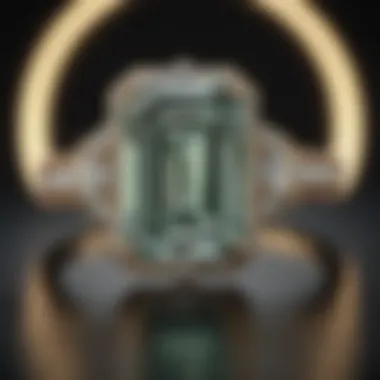

Cleaning an emerald cut diamond doesn’t require a magical solution, yet it does demand a careful approach. Here are some effective guidelines:
- Warm Soapy Water: Mix a few drops of mild dish soap with warm water. Avoid harsh chemicals that can affect the diamond’s setting.
- Soft Brush: Use a soft-bristled toothbrush to gently scrub the stone. Focus on the corners and the underside where dust tends to gather.
- Rinse Thoroughly: Make sure to rinse your diamond under warm running water to remove any soap residue. Remember to cover the drain or do this in a bowl to prevent any slips!
- Lint-Free Cloth: Afterwards, dry your diamond with a lint-free cloth to avoid scratches and keep it sparkling.
Regular cleaning not only maintains the diamond’s shine, but also helps you spot potential issues early, such as loose prongs that might need inspection.
Maintenance Tips
Maintaining an emerald cut diamond involves more than periodic cleaning. Here are some essential tips to keep your gem in prime condition:
- Professional Inspections: At least once a year, have your diamond examined by a jeweler. They can check the setting and ensure the stone is secure.
- Avoiding Hard Surfaces: Be cautious when wearing your diamond ring in situations where it might bump against hard surfaces. This can prevent chips or scratches in its delicate facets.
- Storage Matters: When you're not wearing your diamond, store it in a soft cloth or a protective case. Avoid tossing it in a jewelry box where it might clash with other pieces.
- Mind the Chemicals: Keep your ring away from household cleaners and beauty products like hair sprays or lotions that can dull its surface over time.
By adhering to these cleaning and maintenance guidelines, you can ensure your emerald cut diamond remains a timeless heirloom, radiating beauty and grace for generations.
The Market for Emerald Cut Diamonds
With the rise of unique engagement styles and personal expression in jewelry, the market for emerald cut diamonds has truly started to carve out its niche. Unlike the more mainstream round brilliant cuts, emerald cuts often attract those who appreciate the understated elegance and vintage charm that this particular shape offers. This warrants a keen exploration not only of current trends but also of potential investment opportunities, thus making it vital for enthusiasts and collectors to grasp the evolving landscape.
Emerald cut diamonds may not be as ubiquitous as their round counterparts, but their appeal lies in their classic rectangle shape and captivating step-cut facets. Each facet tells a story, reflecting light in a way that creates an allure of sophistication. Individuals looking to invest or purchase an emerald diamond need to pay attention to specific elements of the market that directly affect value and desirability.
"In the diamond world, rarity often dictates value, and the emerald cut holds a unique place for its charm and distinctiveness."
Current Trends
The current trends in the market for emerald cut diamonds reflect a noteworthy resurgence in popularity. A number of factors contribute to this revival:
- Vintage Aesthetic: Many buyers are drawn to vintage and retro styles, finding that emerald cuts fit beautifully into this category. This trend is evident in bridal collections that prioritize historical elegance.
- Customization: There is an increasing demand for bespoke jewelry designs. Emerald cut diamonds offer a spacious table for intricate crafting and mounting. Designers are diving into unique settings that further accentuate the diamond's elegance, appealing to a clientele that cherishes individuality.
- Social Media Influence: Platforms like Instagram and Pinterest are flooded with images of emerald cut rings worn by prominent influencers and celebrities. This exposure enhances visibility and sparks interest among younger generations, leading to growing demand.
As buyers align with these trends, they also benefit from the dual appeal of purchasing a diamond that is both a stunning gemstone and an investment piece.
Investment Opportunities
Investing in emerald cut diamonds presents several advantages worth considering:
- Stability of Value: Emerald cuts historically hold their value well over time, particularly if the stone has high clarity and color grades. Buyers who pick high-quality options can find that their value appreciates steadily.
- Rarity Factors: Given the specific cutting process and the nature of the stones, well-proportioned emerald cut diamonds can be quite rare. This rarity may lead to increased value as collectors vie for these gems.
- Diverse Market Segment: The appeal of emerald cut diamonds is steadily expanding, capturing interest from both traditional buyers and those looking for modern interpretations. This growing market suggests a promising future for value retention and appreciation.
Emerald Cut Diamonds in Popular Culture
The allure of emerald cut diamonds extends beyond their impressive physical attributes; it resonates deeply within the realms of culture and society. In this section, we will explore how these diamonds are not just seen as gemstones, but as symbols of elegance and status, while also influencing contemporary fashion and celebrity trends. Their unique representation in popular culture adds a layer of intrigue and desirability.
Celebrity Influence
Emerald cut diamonds have found a solid footing in the lives of celebrities, making them increasingly coveted among those enamored with the glitz and glamour of Hollywood. Take, for example, the engagement ring that actress Grace Kelly received from Prince Rainier III of Monaco. This ring, adorned with a stunning emerald cut diamond, didn't just make headlines; it solidified the emerald cut's standing as an iconic choice for engagement rings in the mid-20th century. Celebrities often set trends—not just through their roles in films and television, but through the personal choices they showcase. When a beloved figure like Kate Hudson dons an emerald cut diamond, it breathes life into the stone, elevating it to a must-have piece for fans and admirers alike.
Emerald cut diamonds evoke a classic charm that speaks volumes about sophistication. Their clean lines and understated beauty often symbolize a timeless elegance, making them popular among celebrities who value distinctiveness in their jewelry choices. For example, Beyoncé’s emerald cut diamond engagement ring has not only drawn attention but has also inspired countless brides-to-be in their jewelry selections, further embedding the emerald cut into the fabric of modern culture.
"The emerald cut is all about clarity, and clarity is where the beauty lies. It is the diamond’s personality that shines through, not just its brilliance."
– Johanna Goodman, Jewelry Designer
Role in Fashion
Fashion cycles are relentless, yet certain pieces resonate consistently; emerald cut diamonds certainly fall into this category. Historically, fashion houses have incorporated these diamonds into their designs, elevating their status and appeal. With their striking elongated shape, they complement a range of styles—from vintage to contemporary. Fashion designers recognize the emerald cut as a versatile element that enhances gowns and accessories alike, often pairing them with silk or satin to create a harmonious visual narrative.
Emerald cuts are frequently showcased in runway shows, functioning as statement pieces that exude a sense of luxury. Consider collaborations between renowned designers and jewelry houses that yield stunning collections featuring these diamonds. The fashion world crafts narratives where emerald cuts serve as powerful focal points that captivate audiences and offer an effortless charm.
Furthermore, social media has played a paramount role in reshaping how emerald cut diamonds are perceived. Influencers and style icons share their jewelry choices across platforms like Instagram and TikTok, allowing these stones to reach wider audiences. Hashtags like #EmeraldCut have trend potential, sparking interest and admiration among users who might be unacquainted with this diamond shape.
End: The Allure of Emerald Cut Diamonds
Emerald cut diamonds possess a splendor that’s not merely skin-deep; they represent a unique marriage of style, craftsmanship, and historical significance. As we've explored throughout this article, these diamonds stand apart due to their distinctive geometric form and intriguing play of light. The allure of emerald cut diamonds lies not just in their visual appeal, but in their rich narrative and timeless elegance. They often confer an air of sophistication, making them a sought-after choice for various occasions, particularly engagements and anniversaries.
Summary of Key Points
In summarizing our discussion on emerald cut diamonds, several core aspects shine through:
- Ideal Proportions: These diamonds should ideally maintain a balanced length-to-width ratio, typically between 1.30 and 1.50, ensuring a visually appealing appearance.
- Depth and Table Percentage: A shallow depth can lead to a loss of brilliance, while an ideally proportioned table size enhances the diamond's sparkle.
- Quality Factors: When selecting an emerald cut diamond, clarity and color become vital due to the cut’s transparent nature, which tends to show inclusions more than other cuts.
- Cultural Resonance: From Hollywood stars to fashion runways, emerald cut diamonds have captured hearts, making them a staple in popular culture and trends.
"An emerald cut diamond doesn't just suit a person; it tells their story through elegance and artistry."
Final Thoughts on Selection
When it comes to choosing the right emerald cut diamond, various considerations weigh in. Potential buyers should take time not only to examine the physical characteristics such as cut quality, clarity, and color but also reflect on their personal style and the story they want to convey through their choice. To make an informed decision, spending time visiting jewelers, scrutinizing diamonds under different lights, and asking pertinent questions can be incredibly beneficial.
Moreover, being mindful of market trends and understanding the dynamics of supply and demand can help make a more strategic investment. While the visual aspects are undoubtedly important, the emotional resonance of the piece must not be overlooked. Ultimately, selecting an emerald cut diamond should be less about following trends and more about finding a stone that resonates with one’s own aesthetic and personal journey.



